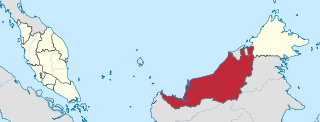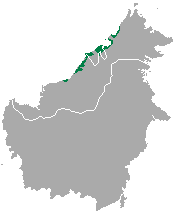
Brunei, formally Brunei Darussalam, is a country located on the north coast of the island of Borneo in Southeast Asia. Apart from its South China Sea coast, it is completely surrounded by the Malaysian state of Sarawak. It is separated into two parts by the Sarawak district of Limbang. Brunei is the only sovereign state entirely on Borneo; the remainder of the island is divided between Malaysia and Indonesia. As of 2020, its population was 460,345, of whom about 100,000 live in the capital and largest city, Bandar Seri Begawan. The government is an absolute monarchy ruled by its Sultan, entitled the Yang di-Pertuan, and implements a combination of English common law and sharia, as well as general Islamic practices.

Sarawak is a state of Malaysia. The largest among the 13 states, with an area almost equal to that of Malaya, Sarawak is located in northwest Borneo Island, and is bordered by the Malaysian state of Sabah to the northeast, Kalimantan to the south, and Brunei in the north. The capital city, Kuching, is the largest city in Sarawak, the economic centre of the state, and the seat of the Sarawak state government. Other cities and towns in Sarawak include Miri, Sibu, and Bintulu. As of the 2020 Malaysia census, the population of Sarawak was 2.453 million. Sarawak has an equatorial climate with tropical rainforests and abundant animal and plant species. It has several prominent cave systems at Gunung Mulu National Park. Rajang River is the longest river in Malaysia; Bakun Dam, one of the largest dams in Southeast Asia, is located on one of its tributaries, the Balui River. Mount Murud is the highest point in the state. Sarawak is the only state of Malaysia with a Christian majority.

Belait District, or simply Belait, is the largest as well as the westernmost district in Brunei. It has an area of 2,727 square kilometres (1,053 sq mi) and the population of 69,062 as of 2016. The administrative town is Kuala Belait, located at the mouth of the Belait River. The district is commonly associated with the oil and gas industry of the country, mainly concentrated near the town of Seria.
The indigenous peoples of Brunei are Bruneian people who belong to the ethnic groups considered indigenous to the country. It is more commonly attributed to indigenous people of the Malay race belonging to the seven ethnic groups, namely: Brunei, Tutong, Belait, Dusun, Murut, Kedayan and Bisaya. The local term rakyat jati refers to citizens of indigenous descent, in particular the aforementioned seven ethnic groups. The term bumiputera has also been sometimes used to refer to the indigenous peoples.
Melanau or A-Likou is an ethnic group indigenous to Sarawak, Malaysia. They are among the earliest settlers of Sarawak. They speak in the Melanau language, which is a part of the North Bornean branch of Malayo-Polynesian languages.
Bolkiah ibni Sulaiman, also known as Nakhoda Ragam, was the 5th Sultan of Brunei. He ascended the throne upon the abdication of his father, Sultan Sulaiman, and ruled Brunei from 1485 to 1524. His reign marked the Golden Age of Brunei and the Spaniards refer to him as Sultan Salan in the Boxer Codex, a 16th century Spanish manuscript. Bolkiah was mentioned in the Batu Tarsilah, a 19th century Bruneian stone tablet which describes the genealogy of the Sultans of Brunei. He was also mentioned in the Silsilah Raja-Raja Berunai, a 19th century manuscript which also describes the same genealogy.

Kampong Sungai Teraban is a village in Belait District, Brunei, near the district's principal town Kuala Belait. It has an area of 22 square kilometres (8.5 sq mi); the population was 1,082 in 2016. It is one of the administrative villages within Mukim Kuala Belait.

There are a number of languages spoken in Brunei. The official language of the state of Brunei is Standard Malay, the same Malaccan dialect that is the basis for the standards in Malaysia and Indonesia. This came into force on 29 September 1959, with the signing of Brunei 1959 Constitution.

Sungai Tujoh, is the westernmost point of Brunei. It is located in the Belait district.

The Lun Bawang is an ethnic group found in Central Northern Borneo. They are indigenous to the southwest of Sabah, and the northern region of Sarawak, highlands of North Kalimantan, Brunei.

Lun Bawang or Lundayeh is the language spoken by the Lun Bawangs. It belongs to the Malayo-Polynesian family.

Bruneian Malays are a native Malay ethnic group that lives in Brunei, the federal territory of Labuan, the southwestern coast of Sabah and the northern parts of Sarawak. The Bruneian Malays are a subgroup of the larger ethnic Malay population found in the other parts of the Malay World, namely Peninsular Malaysia and the central and southern areas of Sarawak including neighbouring lands such as Singapore, Indonesia and Southern Thailand, having visible differences especially in language and culture, even though they are ethnically related to each other and follow the teachings of Islam. All Bruneian Malays who are born or domiciled in East Malaysia even for generations before or after the independence of the states of Sabah and Sarawak from the British Empire through the formation of Malaysia in 1963 are also considered Malaysian Malays in the national census and were in the same status like the Malaysian Malays domiciled in Peninsular Malaysian states and the central and southern parts of Sarawak. They are also defined as a part of the Bumiputera racial classification together as a subgroup within the Malaysian Malay ethnic population along with the Kadazan-Dusuns, Ibans, Malaccan Portuguese and the Malaysian Siamese.

Tatau District is one of the two districts of Bintulu Division in Sarawak, Malaysia. It has a total area of 4,945.80 square kilometres. The largest town in the district is Tatau.

The Limbang District is one of the two districts of Limbang Division, Malaysia. It has a total area of 3,978.10 square kilometres. The major town is Limbang. It has one sub-district, which is Nanga Medamit Sub-District. It borders Brunei Darussalam to the west and east, Lawas District to the southeast and Miri District at the south and southwest. Due to being squeezed in between Brunei at its north and coastal areas, Limbang is accessible by road only by going through immigration posts.

The Brunei Malay language is the most widely spoken language in Brunei and a lingua franca in some parts of Sarawak and Sabah, such as Labuan, Limbang, Lawas, Sipitang and Papar. Though Standard Malay is promoted as the official national language of Brunei, Brunei Malay is socially dominant and it is currently replacing the minority languages of Brunei, including the Dusun and Tutong languages. It is quite divergent from Standard Malay to the point where it is almost mutually unintelligible with it.
The Tutong language, also known as Basa Tutong, is a language spoken by approximately 17,000 people in Brunei. It is the main language of the Tutong people, the majority ethnic group in the Tutong District of Brunei.
Sarawak's population is very diverse, comprising many races and ethnic groups. Sarawak has more than 40 sub-ethnic groups, each with its own distinct language, culture and lifestyle. This makes Sarawak demography very distinct and unique compared to its Peninsular counterpart. However, it largely mirrors to other territories in Borneo - Sabah, Brunei and Kalimantan.
Belait, or Lemeting, is a Malayo-Polynesian language of Brunei and neighbouring Malaysia. It is spoken by the Belait people who mainly reside in the Bruneian Belait District. There were estimated to be 700 speakers in 1995.

The Tutong people are an ethnic group native to Brunei, mainly in Tutong District. They traditionally speak the Tutong language. They are officially recognised as one of the seven ethnic groups of the Bruneian Malay race.

The Bruneian nationality law governs the issues of citizenship and nationality of Brunei. The law regulates the nationality and citizenship status of all people who live in Brunei as well as all people who are of Bruneian descent. It allows the children of expatriates, foreigners as well as residents in Brunei to examine their citizenship status and if necessary, apply for and obtain citizenship of Brunei.














